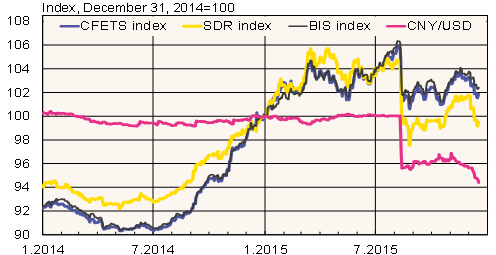BOFIT Weekly Review 51/2015
China publishes yuan exchange rate index
The China Foreign Exchange Trading System (CFETS), the agency under the People’s Bank of China tasked with oversight of currency trading, introduced a CFETS yuan exchange rate index on December 11. The index is based on the weighted average of the currencies of 13 of China’s trading partners. The largest weights in the currency basket are allocated to the US dollar (0.26), euro (0.21), Japanese yen (0.15) and Hong Kong dollar (0.07). The introduction of such index was explained to serve the need for an index that gives a broader perspective on exchange rate trends than the yuan-dollar rate alone. Fluctuations in the yuan-dollar rate are still constrained to a 2 % band based on daily fixing of a yuan-dollar reference rate.
Publication of the index does not mean pegging yuan to it. The yuan’s exchange rate is formally set with reference to a currency basket established in 2005 as part of China’s exchange rate reform. The PBoC has never revealed the precise composition of its currency basket, and the day-to-day exchange rate policy has focused on the yuan-dollar rate.
Publication of the CFETS yuan index has cause uncertainty about its intended role and the direction of central bank exchange rate policy. Some believe that the introduction of the index signals that the PBoC is ready to permit larger fluctuations in the yuan-dollar exchange rate, as the index serves to show a promised relatively stable exchange rate development. With the opening of China’s economy, the trend is nevertheless towards less restrained exchange rate formation.
The yuan has been allowed to weaken against the dollar in recent weeks. On Friday (Dec. 18), one dollar bought 6.48 yuan. The yuan has fallen about 2 % in November–December, and has lost nearly 6 % against the dollar since the end of last year. Measured on the CFETS index, the yuan has risen about 2 % since the end of 2014. CFETS reported that it would begin to publish currency indexes based also on the BIS currency basket (comprises currency of 40 countries) and the IMF’s SDR basket (dollar, euro, pound and yen). Since the end of 2014, the yuan has depreciated nearly 1 % against the SDR basket and appreciated 2 % against the BIS basket.
Yuan-dollar rate and three trade-weighted indexes
Sources: Macrobond, BOFIT